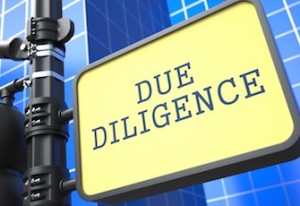 For IP due diligence for investment in a start-up or young company, the most important conversation is with the key developer(s) of the product(s) or service(s) [the “Conversation”]. Ideally, the Conversation is led by an IP attorney who understands the technology. The goal is to determine the source of the product design. Was open source software used? Is this a variation of something an engineer was working on at a prior company? Was a published article used? Perhaps consultants were used? Was the design changed during development after some dead-ends? Where there isn’t budget for a full-fledged investigation, this Conversation and follow-up will likely get 80% of the risks identified for 20% of the cost.
For IP due diligence for investment in a start-up or young company, the most important conversation is with the key developer(s) of the product(s) or service(s) [the “Conversation”]. Ideally, the Conversation is led by an IP attorney who understands the technology. The goal is to determine the source of the product design. Was open source software used? Is this a variation of something an engineer was working on at a prior company? Was a published article used? Perhaps consultants were used? Was the design changed during development after some dead-ends? Where there isn’t budget for a full-fledged investigation, this Conversation and follow-up will likely get 80% of the risks identified for 20% of the cost.
As may be apparent, the answers to these questions will help determine both ownership and risks of a third party suit, the two most important things to determine in IP due diligence. Ideally, the Conversation should occur early in the investigation, but after some initial review of documents (e.g., a list of patent applications) so the IP attorney can ask intelligent questions.
Trade secrets. While the value of patents has been under attack (e.g., with the Supreme Court Alice and Mayo decisions limiting what can be patented and the establishment of IPRs), trade secrets have become a bigger risk with the current rapid changing of jobs by engineers and programmers. A recent example of the risk is the Waymo (Google) trade secret suit against Uber claiming damages of $1.9 billion when a former Waymo engineer joined Uber. The suit settled for equity roughly worth $245 million. Thus, the key developer conversation should explore whether any developers recently came from a competitor.
Willful Infringement under Halo
Under the Supreme Court’s 2016 Halo decision, egregious conduct can lead to willful infringement. One example could be copying with knowledge of a patent. Thus, the conversation with the key developers should uncover the inspiration for the product. There could be a Halo risk if it was modeled on a competitor product, and the developers looked at the competitor patents and decided they didn’t apply without patent attorney analysis. The risk could be mitigated by putting an opinion in place.
Third Party Patent Risks
The key developer conversation should go over the sources used for elements of the product. If a technical article was consulted, the authors should be checked for patents. Similarly, if a competitor product was looked at, the competitor patents can be examined. In any event, the Conversation should identify key competitors, who can be searched for patents.
Consultants, Independent Contractors
The Conversation should identify the main developers and whether any of the developers were outside consultants or independent contractors. With recent trends of classifying people as independent contractors instead of employees, checking their contracts is important. Even for employees, their contracts should be checked for an assignment of inventions, and to make sure there is not a pre-employment patent listed as an exception, which is relevant to the product.
Company Patents
The Conversation should cover any dead-ends during development, and future plans. This will aid a later review of Company patents. Some patent applications may relate to dead-ends the company dropped, and are thus not worth reviewing. Also, oftentimes the developers have already determined that the current design is a stop-gap, and will be changed in a year, thus possibly limiting the value of existing patent applications.
Open Source
The use of open source by programmers is prevalent today. It is hard to find software without some open source piece. Most open source uses won’t present a big problem, but some require licensing the company’s software improvements for free. It is expense to run a software scan for open source components, so the Conversation should identify any significant open source uses so their licenses can be checked.
The answers to the above issues in the Conversation will provide a prioritized roadmap of what to look at and verify by examining written documents and doing further investigation. Unless they overlap, there may be a need to have a separate conversation with management on at least the following issues:
Licenses
Identify whether any of the technology was in-licensed, and those licenses can then be reviewed. Similarly, there should be a query about any out-licensing that may limit the Company’s options.
Trademarks
Many start-ups have initial names that end up changing. Determine the priority of a trademark investigation by asking about any reasons the particular name is important, or whether there are plans to develop a new trademark.
Third Party Patent Risks
Identify whether there have been any IP disputes or any infringement letters or notifications of IP rights have been received, although this is uncommon until the start-up is more visible. Finally, although they rarely exist, ask if the company has done any freedom to operate studies or opinions or other analysis of third party rights.

![[IPWatchdog Logo]](https://ipwatchdog.com/wp-content/themes/IPWatchdog%20-%202023/assets/images/temp/logo-small@2x.png)

![[Advertisement]](https://ipwatchdog.com/wp-content/uploads/2024/04/Patent-Litigation-Masters-2024-sidebar-700x500-1.jpg)

![[Advertisement]](https://ipwatchdog.com/wp-content/uploads/2021/12/WEBINAR-336-x-280-px.png)
![[Advertisement]](https://ipwatchdog.com/wp-content/uploads/2021/12/2021-Patent-Practice-on-Demand-recorded-Feb-2021-336-x-280.jpg)
![[Advertisement]](https://ipwatchdog.com/wp-content/uploads/2021/12/Ad-4-The-Invent-Patent-System™.png)






Join the Discussion
One comment so far.
Night Writer
March 25, 2018 12:02 pm>> Thus, the key developer conversation should explore whether any developers recently came from a competitor.
The tech people that advocate for ridding the world of patents should read this sentence 100 times. Techdirt boys and girls, you want to engage me in a discussion on this topic?